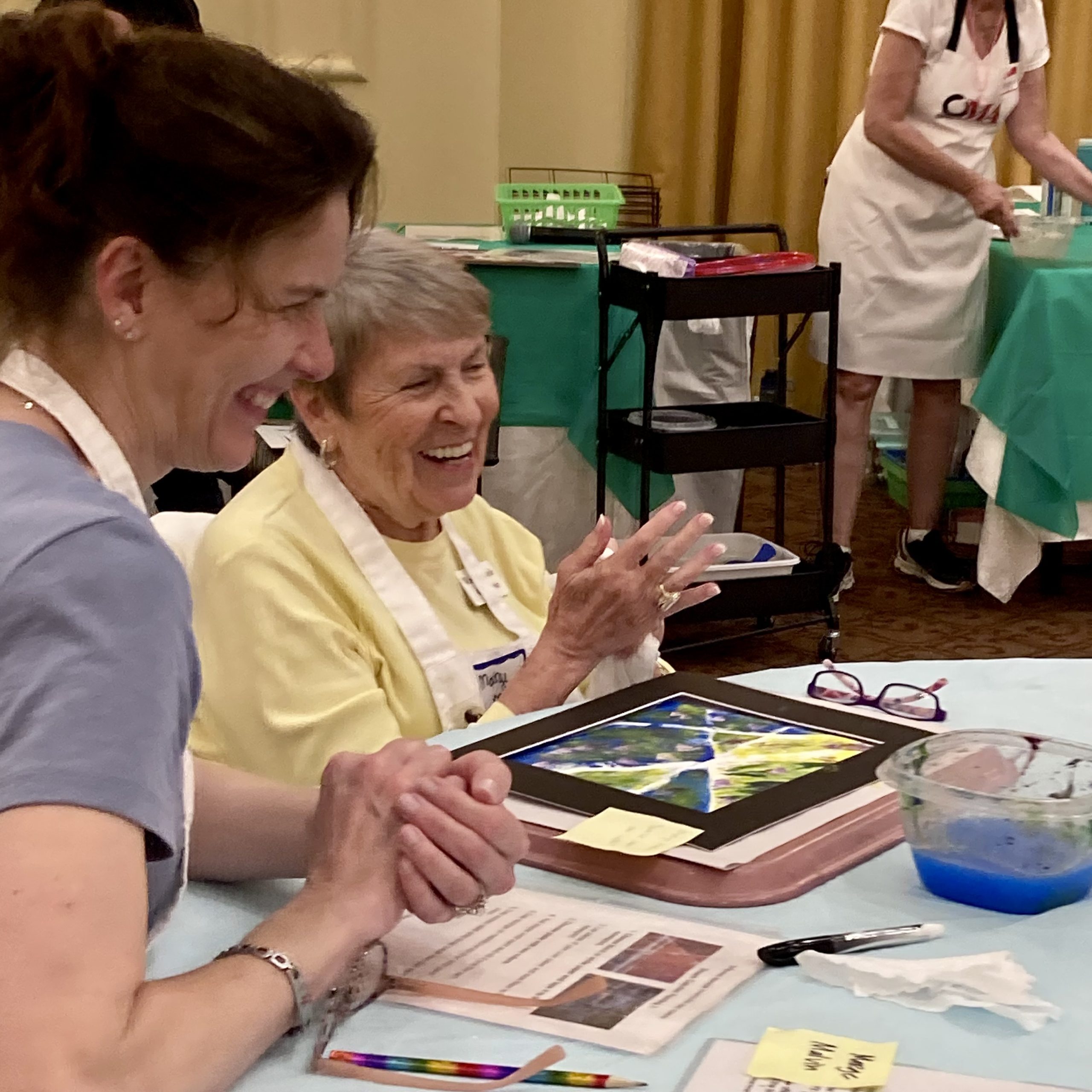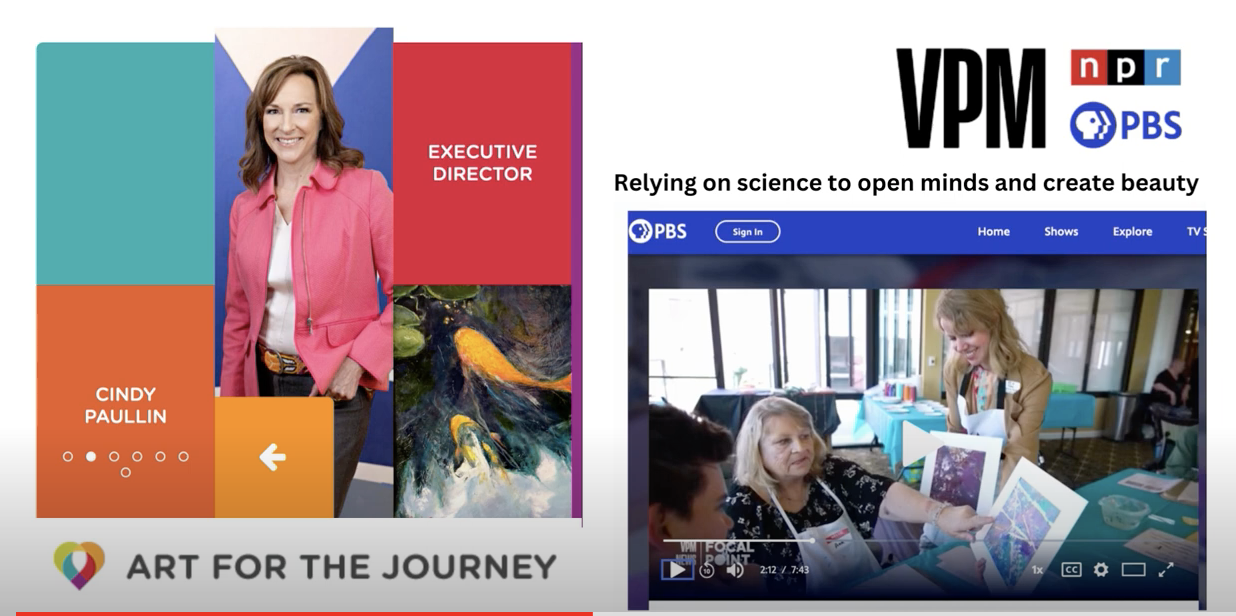As we enter the final year of a large scale expansion of the Scripps Gerontology, “Opening Minds through Art” (OMA) program, we have much to share about the many nursing home staff, seniors, and family members about OMA and the exponential joy factor!
Learn about the funding still available to CMS certified nursing homes!
In case you missed it, catch a glimpse of OMA on Focal Point: Relying on Science to Open Minds and Create Beauty by award winning VPM “Focal Point” Anchor, Angie Miles.
Scroll for an abbreviated transcript.
SALLY GUNN (Resident): You get this piece of paper in front of you and all of a sudden the blank paper becomes filled with color and a theme. It just comes. It’s amazing. So, doing this kind of art was a stretch for me and I’ve just kind of let everything loose and it feels good.
CINDY PAULLIN (Executive Director): This program is personal to me. I was my mother’s caregiver. I felt a sense of not being able to help her as she suffered a stroke and eventually Lewy body dementia. I cared for her in our home and then I cared for her by visiting her in assisted living. And every time I drove away from her, I cried because I couldn’t find a way to save her from this fate. So, years back in 2015, when I learned about this wonderful opportunity, becoming certified in OMA was life-changing for me.
Don’t ever say, you can’t do this. Just take a step and try. And once you try, you will succeed and you feel good about yourself, that your mind is good, that you can do it, you know? -OMA Artist
DIANNE SIMONS (Lead OMA Trainer): OMA restores energy and love and passion and joy and connection. And there are so many people in nursing homes who need people attention and they need to exercise their creativity, their minds, and their talents and their abilities. We do something called Inspirations where the artist is shown a couple of examples of the project that’s going to be done that day. And they’re intentionally very different; different colors, different designs. They all end up unique. But you ask them, ‘Which do you prefer?’ So that’s the question the volunteer asks, “Which one do you like better?” And that involves increased brain activity to move because they have to look left, they have to look right. And in that process, it requires their cognition and for them thinking. But there’s no right or wrong answer.
STEPHANIE SHANKS (OMA Grant Project Manager): The process of creating a piece of OMA art is structured so that you know what to do at each step of the way. But choices are also built into the process. So, everybody both feels empowered by knowing that there’s a next step that they’re not going to have to take a risk that’s too big for them but also that they can make a choice and feel really free to choose the blue and the green colors together or the pink and the yellow. And they know that those will work well together. So that’s an empowering aspect of the failure-free design.
NAN PASCAL (St. Mary’s Woods OMA Facilitator): I learned that amazing art can be created by people who have what they perceive as no artistic talent. And when I invite a resident to participate in an OMA class the very first thing that they say to me is, “but I’m not an artist.” So now I say, ‘Good, I’m glad you’re not. I think you’re really going to like OMA.’
Melba Gibbs: I’m not an artist. I couldn’t tell you Monet from Picasso, but I can see how it impacts those older people when they come in and they are, “I don’t really know where I am.” “I don’t know what I’m going to do.” But by the time they leave, they are smiling, they are remembering things and they are so happy to see you the next week.
STEPHANIE: OMA is the Dutch word for grandmother. So, at the root of OMA is this grandchild-style relationship. From there, there’s all sorts of things that create a rewarding experience for both sides of the partnership. Just the fact of attentive presence, two people paying attention to each other for a set amount of time each week, amazing things can happen. People become known and seen. And that’s true for both someone who might be isolated in a long-term care community as well as someone who might be isolated in a dorm room. Social isolation is really an epidemic. And so, to create a space where people can connect genuinely to enjoy each other’s company, to feel human, to feel dignified, to feel creative, to feel accomplished, is just really powerful. And I’ve so enjoyed watching it unfold.
NAN: Healthcare tells people, “Oh, you can’t do this” or they’re compensating for the things that they can’t do. But we have had residents with handicaps that participated fully in OMA with just some simple adaptations. So, it just was the right thing to do. And I was very, very thankful that they came here and said, “Would you like to do this?”


DIANNE: And the exciting thing to me was someone with full cognition could work side by side with someone with limited cognition and you couldn’t tell who had done which project. The projects are are failure-free. OMA changes people; it changes the facilitators; it changes the people who volunteer. It changes the artist. It is transformational.
SALLY: A lot of us have health issues, and it kind of takes your mind off of what you might be feeling, and you feel this joyous, happy mood with your art. And it’s a blessing. It really is. I just feel like you get transformed as soon as you walk into the OMA room. And it’s nice having a partner with you. That is very, very special. I usually come in happy, and I leave very happy.
BARBARA THORNTON (Resident): And your life should be full of joy and happiness and things. And don’t ever say, you can’t do this. Just take a step and try. And once you try, you will succeed and you feel good about yourself, that your mind is good, that you can do it, you know? Hmm.
This Virginia – State – Wide expansion of the OMA program is made possible by grant-funding from the Department of Medicaid Services (DMAS), and through a dedicated partnership between LeadingAge Virginia and Art for the Journey. Through training and certification, this best practice program which was developed by gerontologist, Dr. Elizabeth Lokon, is now more widely available to positively impact many more lives, seniors, family members, staff and the public at-large.
Thank you Angie Miles for creating this wonderfully told report for VPM’s “Focal Point”, it was an honor sharing days with you and your team!
